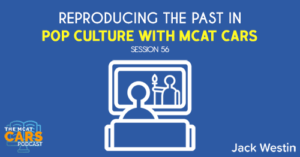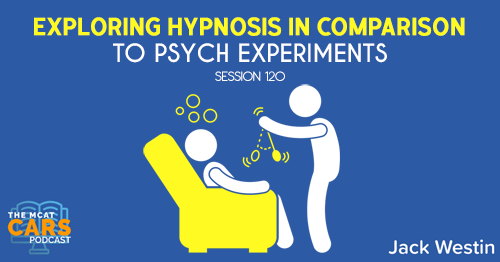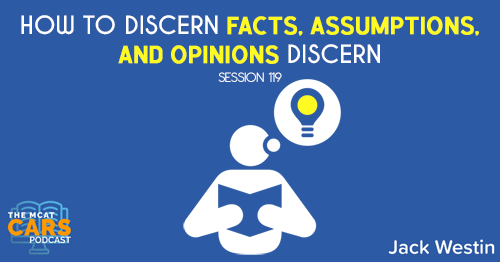Apple Podcasts | Google Podcasts

Session 56
Whether you enjoy a CARS passage or not, you have to get used to the discomfort! Here, we dive into visual culture, smartphones, and resurrecting the past.
Check out all of the resources Jack Westin has to offer including his courses and his free daily CARS passages that go right to your email inbox. If you’re looking at one of his courses, text CARSCOUPON to 44222. This will activate a $100 off coupon.
Listen to this podcast episode with the player above, or keep reading for the highlights and takeaway points.
Link to article:
https://productivityhub.org/2019/05/30/hanging-on-the-telephone-real-life/amp/
Films set in today’s world are often stunted when it comes to representing what contemporary life looks like. This is because they tend to shy away from one of its defining aspects: phones. So much of life is now lived on and through screens, yet phones don’t typically get much visual attention. In the view of many filmmakers, the imagery of a screen on a screen presents certain obstacles to visual storytelling. Greta Gerwig, for instance, said her decision to set her 2017 film Lady Bird in 2002 was based, in part, on her notion that “to make a movie about teenagers now, you have to shoot cell phones…Their [lives] happen online and I don’t think it’s very cinematic.” This seems to be a commonly shared sentiment among industry professionals, as the sustained trend of recent-history period pieces like Once Upon a Time In Hollywood, Mid-90s, and PEN15 suggests. The popular film and television landscape is increasingly shaped by the void of contemporary stories that directors, screenwriters, and showrunners don’t want to tell.
Instead, the current landscape is marked by pastiche, period pieces, and nostalgia-fueled revivals and remakes. Take the best picture nominees from the 2019 Academy Awards: six out of eight are period pieces, one is a remake (A Star is Born), and one revives a comic book character from the 1960s (Black Panther). Though the Oscars purport to highlight the cinematic excellence of the present, they more effectively demonstrate how attached we are to the past.
Simon Reynolds, in his 2010 book Retromania, attributes this attachment in part to “a crisis of overdocumentation.” All the styles of the past are available at our fingertips online: I can mine YouTube and stream documentaries from the 1970s; I can browse troves of vintage Levis on Etsy. Mark Fisher echoed this sentiment in his diagnosis of popular music, which he described as 20th century sounds repackaged on 21st century platforms. In Ghosts of My Life, he recalls hearing Amy Winehouse’s cover of “Valerie” for the first time in a shopping mall. He knew it was a remake of the Zutons’ 2006 song, but it was sonically displaced to the 1960s, Fisher noted, by “the souped-up retro style” of producer Mark Ronson.
Fisher and Reynolds borrowed Jacques Derrida’s term “hauntology” to refer to how future innovation is being canceled by the persistence of past modes in contemporary cultural production. Hauntological works offer an idealized image or sound from the past, coupled with anachronisms that give the feeling that, as Derrida emphasized, “time is out of joint.” The appropriation of outdated aesthetics has corrupted our sense of historicity, breeding works that appear to be set outside of time. As George Steiner wrote in In Bluebeard’s Castle, “It is not the literal past that rules us … It is images of the past.”
The ubiquity of cultural pastiche is not new and certainly predates the internet. Fredric Jameson saw pastiche as integral to postmodernism, which in a 1991 book he dubbed the “cultural logic of late capitalism.” Central to his argument was the idea that postmodern pastiche colonizes history to glean empty stylizations for reproduction and consumption. One of his examples was Lawrence Kasdan’s 1981 noir Body Heat, which was technically set in the 1980s but studiously evaded period details to evoke an aesthetic of “pastness.” The opening credits are in a Chinatown-style art-deco font; the quaint, small-town setting is far from the then new glass-and-steel high-rises; and any artifacts that would date the image are kept out of frame. The film, Jameson writes, “conspires to blur its official contemporaneity and make it possible for the viewer to receive the narrative as though it were set in some eternal thirties, beyond real historical time.” In his view, this kind of pastiche was a retreat from the challenge of innovation posed by modernism, a movement that rejected tradition and called for artistic experimentation in efforts to adequately depict contemporary life. Modernism implied a belief that new art forms could catalyze positive social change by forcing audiences to find new ways of seeing. Postmodernism, by contrast, suggests everything has been done before; nothing is new — capitalistically catering to audiences by producing new versions of things they liked in the past (Think: Ghostbusters, but female).
[08:14] Paragraph 1, Sentence 1
Films set in today’s world are often stunted when it comes to representing what contemporary life looks like.
Jack says:
The author is saying that movies don’t exactly represent contemporary life at this point.
[08:50] Paragraph 1, Sentence 2
This is because they tend to shy away from one of its defining aspects: phones.
Jack says:
We all live with our phones nowadays.
[09:00] Paragraph 1, Sentence 3
So much of life is now lived on and through screens, yet phones don’t typically get much visual attention.
Jack says:
“Contemporary” means current, now. And phones are part of our contemporary lives.
[10:00] Paragraph 1, Sentence 4
In the view of many filmmakers, the imagery of a screen on a screen presents certain obstacles to visual storytelling.
Jack says:
The author is telling us why filmmakers don’t show screens.
[10:19] Paragraph 1, Sentence 5
Greta Gerwig, for instance, said her decision to set her 2017 film Lady Bird in 2002 was based, in part, on her notion that “to make a movie about teenagers now, you have to shoot cell phones…Their [lives] happen online and I don’t think it’s very cinematic.”
Jack says:
One director or producer made a movie set before cellphones were a big thing. So she’s avoiding cellphones. She’s avoiding contemporary culture or lives in filming because of the cellphone.
The previous sentence said, the cellphone is an “obstacle to storytelling” hence, she thinks it’s not very cinematic.
[12:10] Paragraph 1, Sentence 6
This seems to be a commonly shared sentiment among industry professionals, as the sustained trend of recent-history period pieces like Once Upon a Time In Hollywood, Mid-90s, and PEN15 suggests.
Jack says:
The author is giving more examples of other films that are trying to stay away from phones.
[12:34] Paragraph 1, Sentence 7
The popular film and television landscape is increasingly shaped by the void of contemporary stories that directors, screenwriters, and showrunners don’t want to tell.
Jack says:
“No phones in movies” is really the takeaway from this.
[13:00] Paragraph 2, Sentence 1
Instead, the current landscape is marked by pastiche, period pieces, and nostalgia-fueled revivals and remakes.
Jack says:
Pastiche probably means past, old.
[13:47] Paragraph 2, Sentence 2
Take the best picture nominees from the 2019 Academy Awards: six out of eight are period pieces, one is a remake (A Star is Born), and one revives a comic book character from the 1960s (Black Panther).
Jack says:
The author is giving more examples here as to what’s going on.
[14:05] Paragraph 2, Sentence 3
Though the Oscars purport to highlight the cinematic excellence of the present, they more effectively demonstrate how attached we are to the past.
Jack says:
The current movies are all about the older days. And maybe this could be because of the phones. The author thinks it’s because of the phones.
[15:06] Paragraph 3, Sentence 1
Simon Reynolds, in his 2010 book Retromania, attributes this attachment in part to “a crisis of overdocumentation.”
Jack says:
A book mentioned here. We still don’t know what this means at this point so let’s keep on reading.
[15:32] Paragraph 3, Sentence 2
All the styles of the past are available at our fingertips online: I can mine YouTube and stream documentaries from the 1970s; I can browse troves of vintage Levis on Etsy.
Jack says:
This overdocumentation is just this act of being able to see past historical themes and features. You can browse vintage stuff and understand historical context better because of this accessibility. Notice that we’re not talking about the phones anymore but we’re going down this path that is more focused on the culture itself.
[16:39] Paragraph 3, Sentence 3
Mark Fisher echoed this sentiment in his diagnosis of popular music, which he described as 20th century sounds repackaged on 21st century platforms.
Jack says:
It’s not just movies, but also music apparently.
[17:11] Paragraph 3, Sentence 4
In Ghosts of My Life, he recalls hearing Amy Winehouse’s cover of “Valerie” for the first time in a shopping mall.
Jack says:
The author is giving an example here backing this up with some data to show why his idea is right.
[17:35] Paragraph 3, Sentence 5
He knew it was a remake of the Zutons’ 2006 song, but it was sonically displaced to the 1960s, Fisher noted, by “the souped-up retro style” of producer Mark Ronson.
Jack says:
The author is talking about why this music eas sonically displaced to the 60’s.
The big picture in this paragraph is not focused on phones anymore but on our culture and how it’s documented to make us bring that out.
[18:40] Paragraph 4, Sentence 1
Fisher and Reynolds borrowed Jacques Derrida’s term “hauntology” to refer to how future innovation is being canceled by the persistence of past modes in contemporary cultural production.
Jack says:
Jacques is saying we aren’t creating a future and we’re just hanging on to the past.
[19:35] Paragraph 4, Sentence 2
Hauntological works offer an idealized image or sound from the past, coupled with anachronisms that give the feeling that, as Derrida emphasized, “time is out of joint.”
Jack says:
Time is not where it is. And this is what anachronism means.
[20:33] Paragraph 4, Sentence 3
The appropriation of outdated aesthetics has corrupted our sense of historicity, breeding works that appear to be set outside of time.
Jack says:
We’re creating things that don’t seem to be set in our current time. This is the consistent theme throughout the entire article.
[21:09] Paragraph 4, Sentence 4
As George Steiner wrote in In Bluebeard’s Castle, “It is not the literal past that rules us … It is images of the past.”
Jack says:
Another example of another writer basically saying the same thing. The author is being more specific. They usually provide more context to allow you to better understand this.
It’s not necessarily that we’re ruled by the past. Instead, we’re ruled by its images. The documentation of it is leading to our sense of holding on to the history.
[22:13] Paragraph 5, Sentence 1
The ubiquity of cultural pastiche is not new and certainly predates the internet.
Jack says:
It happens before the internet. You don’t need YouTube. It could be happening before YouTube.
[23:31] Paragraph 5, Sentence 2
Fredric Jameson saw pastiche as integral to postmodernism, which in a 1991 book he dubbed the “cultural logic of late capitalism.”
Jack says:
So we need this pastiche. Maybe there’s importance to it. There’s some kind of connection that’s necessary.
[24:17] Paragraph 5, Sentence 3
Central to his argument was the idea that postmodern pastiche colonizes history to glean empty stylizations for reproduction and consumption.
Jack says:
For this postmodernism, we have to look at the past to create styles and stuff. This is consistent with the previous sentences.
[25:05] Paragraph 5, Sentence 4
One of his examples was Lawrence Kasdan’s 1981 noir Body Heat, which was technically set in the 1980s but studiously evaded period details to evoke an aesthetic of “pastness.”
Jack says:
The author is giving an example of a film avoiding period details from the 80’s to make it look more from the past.
[25:43] Paragraph 5, Sentence 5
The opening credits are in a Chinatown-style art-deco font; the quaint, small-town setting is far from the then new glass-and-steel high-rises; and any artifacts that would date the image are kept out of frame.
Jack says:
The author is describing how they’re evoking this “pastness.”
[26:04] Paragraph 5, Sentence 6
The film, Jameson writes, “conspires to blur its official contemporaneity and make it possible for the viewer to receive the narrative as though it were set in some eternal thirties, beyond real historical time.”
Jack says:
This is an example of this movie that’s using past kinds of themes.
[26:31] Paragraph 5, Sentence 7
In his view, this kind of pastiche was a retreat from the challenge of innovation posed by modernism, a movement that rejected tradition and called for artistic experimentation in efforts to adequately depict contemporary life.
Jack says:
This movie goes against innovation because it mentioned “retreat” so it’s stepping back. It’s avoiding the challenge of innovation. The author is suggesting that maybe the challenge of innovation posed by modernism is bad.
And they defined what postmodernism is, which is a movement of rejected tradition and called for artistic experimentation.
[27:58] Paragraph 5, Sentence 8
Modernism implied a belief that new art forms could catalyze positive social change by forcing audiences to find new ways of seeing.
Jack says:
The author is explaining why there is this push to innovate and it’s because they wanted the audience to find new ways of seeing.
[28:20] Paragraph 5, Sentence 9
Postmodernism, by contrast, suggests everything has been done before; nothing is new — capitalistically catering to audiences by producing new versions of things they liked in the past (Think: Ghostbusters, but female).
Jack says:
There’s nothing new that can be done so they’re just going to give people what they want.
[29:05] The Big Picture
We like to look to the past and creating more than we’re ever doing it than before because of the internet. This documentation is dominating our contemporary culture – not just in movies, but in everything. Our culture as a whole is dominated by images of our past.
[30:15] Final Thoughts
You don’t really need to read these big words. Just try to summarize and bring it all into context. Be confident that you’re not going to be dependent on one word or one sentence to get the big picture.
Links:
Link to article:
https://productivityhub.org/2019/05/30/hanging-on-the-telephone-real-life/amp/
SEARCH SITE
SEARCH SITE
LISTEN FOR FREE











